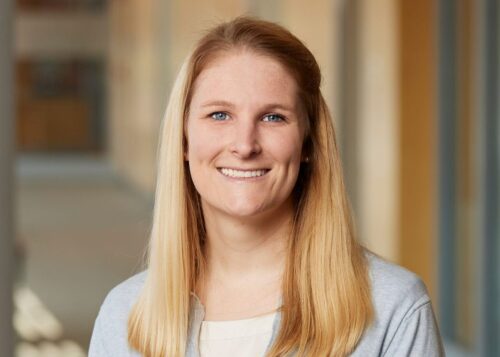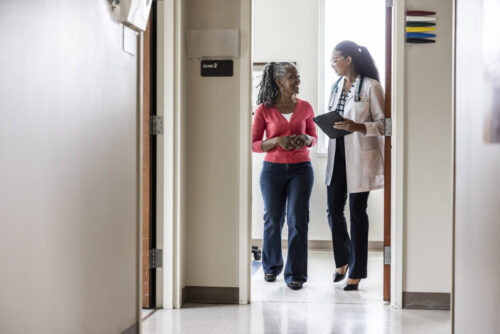
The Abundance mobile app locates nearby free and low-cost food resources and allows users to leave public feedback on quality and service, to Yelp-like effects.
Choosing between paying rent and buying food is a decision we all hope never to face. But the truth is, many families — roughly 12% of U.S. households — live with food insecurity, which means they’re not certain they’ll have enough food to feed everyone in their household. Many more people lack consistent access to enough affordable and nutritious food to sustain a healthy, active life.
Food pantries and nutritional assistance programs are meant to help, but they have their shortcomings. All too often, pantries and other free and low-cost sources of food have limited selections — an important factor for those with dietary restrictions or chronic health conditions — or haven’t thoughtfully considered their customer experience. These food sources can also be hard to track down, especially for those with limited time and experience navigating the many options.
A new mobile app, Abundance, is aiming to fill these gaps. A grassroots effort launched in Boston by social worker Suzeth Dunn-Dyer, the director of resident services at Inquilinos Boricuas En Acción, the app includes an interactive map of food resources around the city and the opportunity for users to provide feedback on the quality of the food and customer service.
Abundance was designed to address the full range of barriers to food security, which extend far beyond the logistics of accessing free and low-cost food to include the shame and stigma people feel, or are made to feel, in the process.
“We wanted to create an app not just to provide information about local resources,” says Dunn-Dyer, “but also to empower the residents’ voices.”
Listening to community voices on the scope of food insecurity
The idea for the Abundance app was sparked by a Boston teenager named Robert. One day in 2017, Robert told Dunn-Dyer — who was mentoring him at the time — that he was hungry. She quickly offered to buy him some Jamaican patties for dinner. But as Robert revealed, he was hungry in a way that couldn’t be remedied with a single meal.
“He said, ‘No, I really need you to talk to my mom, and help my mom,'” Dunn-Dyer recalls.
Robert was so chronically hungry that it was interfering with his ability to focus in school. The hunger pains in the pit of his stomach were so severe that they led him, at times, to steal food from corner stores.
Deeply troubled by Robert’s story, Dunn-Dyer reached out to her longtime associate Renée Boynton-Jarrett, MD, the founding director of Vital Village, a network of residents and organizations committed to maximizing child, family, and community wellbeing.
Dunn-Dyer and Boynton-Jarrett convened a workgroup to brainstorm solutions for food insecurity. The workgroup included community members, university and graduate school students, and individuals from partner organizations such as the Boston Public Health Commission, the Mayor’s Office of Food Access, the Madison Park Development Corporation, the Greater Boston Food Bank, and Project Bread.
The scope and depth of food insecurity quickly came to light during the sessions. The participants shared stories of food pantries with expired food or with limited produce and mostly starches — a less-than-healthy balance for anybody, but especially for people with diabetes or other chronic conditions. What’s more, even when healthy food options are available, they may not be culturally relevant for the community.
“That workgroup was incredibly powerful,” Boynton-Jarrett says. “It really proves that you learn different information when you follow the lead of members within the community that you’re hoping to serve.”
The community input ultimately shaped the features of the app itself. Dunn-Dyer and the app developers had originally planned to map only food pantries, but community members voiced that they wanted to see additional resources. When Abundance launched, it also included info on supermarkets and grocery stores, food pantries, farmer’s markets, and senior dining sites, pulled from data sources such as the Mayor’s Office of Food Access.
The launch of the app is just one step in reframing the conversation about food insecurity around community assets. The app’s development demonstrates that food insecurity is a systemic issue requiring an integrated approach and a network of people working together, the most important of whom are those experiencing food insecurity themselves.
Fighting stigma as a barrier to food access
The stigma attached to using emergency food services is a major barrier to accessing low- or no-cost food. Dunn-Dyer and Boynton-Jarrett had heard in the workgroups that free food could feel like a handout, the limited selection of foods was disempowering, and customer service at pantries was often poor. Solving the problem of food insecurity became more than a question of access, but a question of dignity.
“We don’t see the invisible cost to people’s sense of pride,” Boynton-Jarett explains.
The Abundance app’s Yelp-like reviews feature, which enables consumers to rate and review the food resources they’ve visited, was designed to give voice to residents and create accountability. Food providers can use the review data to make improvements or build on strengths, while other app users can use the information to make choices that provide healthier options and a more dignified experience.
Josh Trautwein, the founder of Fresh Truck, a nonprofit mobile produce market that’s discoverable within the Abundance app, embraces the accountability that the app and other review sites bring.
“Any nonprofit worth its chops should want that feedback, for better or worse. To know what’s going well, what’s going wrong,” he says. “You spot patterns and then you build on it from there.”


Fresh Truck, a nonprofit mobile market included in the Abundance app that sells produce in retrofitted school buses, has thought carefully about the shopping experience it provides. (Getty Images)
Trautwein and his team are sensitive to the stigma surrounding free and low-cost food resources, so they’ve taken care to emulate the experience of a typical grocery store in several ways, from ensuring that the truck is attractive, to stocking culturally-relevant ingredients at celebration times, to making sure that all purchases of free or discounted food involves a transaction between the customer and cashier.
“I think there are some constraints around food pantries that make it difficult to deliver a dignified shopping experience,” he says. “So we really worked hard to be intentional about creating an experience that honored our communities.”
Raising awareness to help solve food insecurity
Dunn-Dyer and her partners are actively collecting feedback on the app. For instance, a recent session with young people at Camp Harbor View, which runs a summer camp for underserved youth and a year-round leadership academy in Boston, elicited some valuable feedback for the developers about the unique needs and challenges that teenagers face in accessing free and low-cost food.
Some food pantries require identification or proof of income, which can exclude clients who are under 18. And because young people aren’t generally shopping for their whole families, their food preferences and usage patterns tend to differ from those of adults.
Dunn-Dyer is already brainstorming some new features, including the ability for residents to share their stories about food insecurity through the app or the Abundance website. Her hope is that collecting those stories and making them heard will raise awareness of food insecurity and ultimately lead to policy changes to address the root causes of the issue.
“This is a major, major issue,” she says, “and not enough people are talking about it.”


